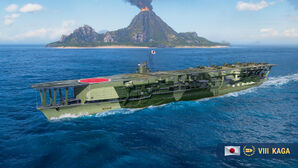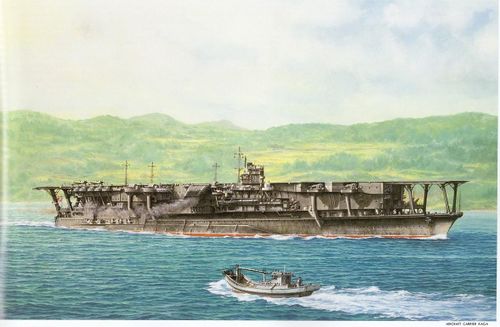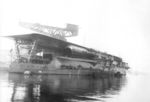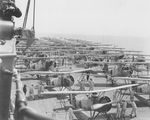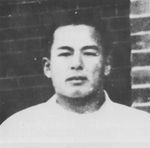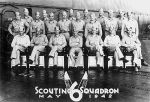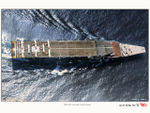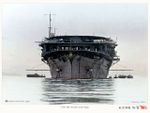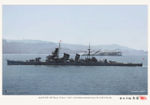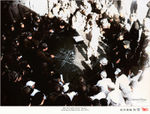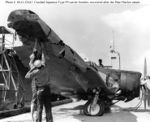Kaga
| Revision as of 23:45, 3 June 2017 Reformatted History Tab | Revision as of 04:24, 4 June 2017 Smoothed out Service History section. | |||
| Line 192: | Line 192: | |||
| ===Service=== | ===Service=== | |||
| ? | + | Four years after her completion and commission, ''Kaga''’s first combat action came in early 1932 where ''Kaga'', flagship of the 1st Carrier Division alongside ''[[Hosho]]'', spent the entirety of February supporting the Imperial Japanese Army’s attack on the Chinese coastal lynchpin of Shanghai. During these engagements, three of ''Kaga''’s Nakajima A1N2 fighters scored the IJN’s first air-to-air combat victory in late February against the Chinese forces. Following the ceasefire on the 3rd of March, ''Kaga'' and ''[[Hosho]]'' returned to the Combined Fleet to resume training exercises. These early carrier exercises were vital to the development of both Japanese and international carrier doctrines. Aircraft carriers were initially intended to act as force multipliers in the Imperial Japanese Navy, primarily by supporting the fleet’s Battleships as per the “decisive battle” doctrine. As carrier doctrine evolved, aerial strikes against enemy carriers became of equal importance to battleship engagements, to secure air superiority during a battle to allow carriers to attack enemy surface vessels with little to no danger from enemy fighters. Aircraft carriers would operate with or ahead of the main battleline, and an emphasis on high top speed and larger aircraft requiring longer flightdecks. Due to this shift in ideology, ''Kaga'' was judged inferior to her half-sister ''Akagi'' due to her lower top speed and smaller flight deck, on top of her problematic funnel arrangement, and was first in line for an extensive reconstruction that lasted from 1934 until the middle of 1935. | ||
| ? | Following the completion of her reconstruction, ''Kaga'' was assigned to Carrier Division 2 as the only carrier of the division, where she trained for another two years until the Marco Polo Bridge incident that sparked the full-on war between Japan and the Chinese coalition that was the Second Sino-Japanese War. In 1937, ''Kaga'' joined CarDiv 1 alongside ''[[Ryujo]]'' and ''[[Hosho]]'' to attack central and southern China with the IJN, while the IJA pushed down from the north. ''Kaga''’s air group engaged the Chinese Airforce over central China, with mixed successes. An attack group consisting of 29 attack planes and 16 bombers with no fighter escort took off to strike multiple targets on the Chinese coastline. They were forced to change targets due to bad weather and | + | Following the completion of her reconstruction, ''Kaga'' was assigned to Carrier Division 2 as the only carrier of the division, where she trained for another two years until the Marco Polo Bridge incident that sparked the full-on war between Japan and the Chinese coalition that was the Second Sino-Japanese War. In 1937, ''Kaga'' joined CarDiv 1 alongside ''[[Ryujo]]'' and ''[[Hosho]]'' to attack central and southern China with the IJN, while the IJA pushed down from the north. ''Kaga''’s air group engaged the Chinese Airforce over central China, with mixed successes. An attack group consisting of 29 attack planes and 16 bombers with no fighter escort took off to strike multiple targets on the Chinese coastline. They were forced to change targets due to bad weather, and were then intercepted by Chinese fighters, losing eight attack planes and surrendering a ninth. Exact total losses are unclear, but it was enough to forbid any aerial bombing mission without fighter escorts. Japanese fighters, however, often had great success against the exported American fighters the Chinese Airforce used, suffering little to no losses in dogfights while escorting Japanese attack aircraft. ''Kaga''’s final attack during this sortie was several strikes against the Chinese light cruisers ''Ping Hai'' and ''Ning Hai''. Both ships sunk in the banks of the Yangtze River, to later be risen and put into service by the IJN. ''Kaga'' and CarDiv 1 spent the rest of 1937 moving to and from mainland Japan and occupied China, ferrying aircraft for land bases or carrying out strikes herself. In December 1937, a group of IJN aircraft launched from ''Kaga'' attacked three oil barges escorted by the American river gunboat USS ''Panay'' (PR-5), sinking the three barges and USS ''Panay'', taking American lives with it. This resulted in “The Panay Incident”, which while Japan apologized to the USA and paid an indemnity, but this nonetheless turned US opinion against Japan. | |
| ? | ''Kaga'' continued supporting Japanese attacks on central China until the end of 1938, where she returned to Japan and was placed in reserve status to undergo a second lengthy overhaul, lasting until late 1940. ''Kaga''’s experiences off China further solidified the advanced IJN carrier doctrine, emphasizing on the | + | ''Kaga'' continued supporting Japanese attacks on central China until the end of 1938, where she returned to Japan and was placed in reserve status to undergo a second lengthy overhaul, lasting until late 1940. ''Kaga''’s experiences off China further solidified the advanced IJN carrier doctrine, emphasizing on the importance in amassing and concentrating naval air power offshore for successful land attacks. In April 1941, the IJN formed the First Air Fleet that placed all its fleet carriers under a single command. ''Kaga'' joined the First Carrier Division alongside her half-sister ''Akagi'', spending most of 1941 training with their new-age aircraft in preparation for the Attack on Pearl Harbor. With training complete by November that year, ''Kaga'' moved to the Kurils to prepare for the secret Hawaii Operation, where the IJN amassed their naval power. By December 6th, 1941, ''Kaga'' and the Combined Fleet of the IJN were 400 miles north of Hawaii, where the fleet oilers present detached with a destroyer escort before the carriers continued into Hawaiian waters to enter striking range. | |
| ? | On the morning of December 7th, 1941, 183 aircraft, 35 launched from ''Kaga'', formed the first attack wave and struck Pearl Harbor. These attack planes targeted the battleships USS ''Arizona'' (BB-39), USS ''West Virginia'' (BB-48), USS ''Tennessee'' (BB-43), USS ''Oklahoma'' (BB-37) and USS ''Nevada'' (BB-36), causing the magazine detonation of ''Arizona'', the capsizing of ''Oklahoma'', severe damage to ''West Virginia'', medium damage to ''Nevada'', and only mild damage to ''Tennessee''. After the first wave, the second wave of 167 aircraft, 32 launched from ''Kaga'', struck Pearl Harbor again, her fighters wreaking havoc on the grounded aircraft at the airfields, and her aircraft striking ''West Virginia'' a second time, causing her to sink, forcing ''Nevada'' to beach herself and only dealing minor damage to USS ''Maryland'' (BB-46). By 0945, the planes had retired to their home carriers, with ''Kaga'' taking the heaviest losses, losing 15 | + | On the morning of December 7th, 1941, 183 aircraft, 35 launched from ''Kaga'', formed the first attack wave and struck Pearl Harbor. These attack planes targeted the battleships USS ''Arizona'' (BB-39), USS ''West Virginia'' (BB-48), USS ''Tennessee'' (BB-43), USS ''Oklahoma'' (BB-37) and USS ''Nevada'' (BB-36), causing the magazine detonation of ''Arizona'', the capsizing of ''Oklahoma'', severe damage to ''West Virginia'', medium damage to ''Nevada'', and only mild damage to ''Tennessee''. After the first wave, the second wave of 167 aircraft, 32 launched from ''Kaga'', struck Pearl Harbor again, her fighters wreaking havoc on the grounded aircraft at the airfields, and her aircraft striking ''West Virginia'' a second time, causing her to sink, forcing ''Nevada'' to beach herself and only dealing minor damage to USS ''Maryland'' (BB-46). By 0945, the planes had retired to their home carriers, with ''Kaga'' taking the heaviest losses, losing 15 of the 29 total aircraft lost. ''Kaga'' and the other carriers withdrew to mainland Japan, before ''Kaga'' departed for Truk in January 1942, a crucial Japanese naval base in the Caroline Islands, joining ''Akagi'' to prepare for the Japanese invasions of Rabaul and Kavieng. | |
| ? | Departing from Truk with a large surface fleet including ''Kaga'', ''Akagi'', ''[[Shokaku]]'', ''Zuikaku'', and the battleships ''Hiei'' and ''Kirishima'', on the 20th of January 1942 100 attack aircraft, 36 from ''Kaga'', | + | Departing from Truk with a large surface fleet including ''Kaga'', ''Akagi'', ''[[Shokaku]]'', ''Zuikaku'', and the battleships ''Hiei'' and ''Kirishima'', on the 20th of January 1942 100 attack aircraft, 36 from ''Kaga'', struck the port of Rabaul in New Britain. ''[[Shokaku]]'' and ''Zuikaku'' of Carrier Division 5 detached and moved to the Bismarck Sea, and CarDiv 1 struck the port of Kavieng, New Ireland, while CarDiv 5 strike ports along the northern shores of New Guinea. ''Kaga''’s planes struck Rabaul again, securing aerial control of the area and continuing aerial patrols before regrouping with the other carriers and returning to Truk by the end of the month. ''Kaga and Akagi'', alongside Carrier Division 2’s ''Soryu'' and ''[[Hiryu]]'', moved with a large Japanese fleet to strike Port Darwin on the northern coast of Australia, in mid-February 1942. This strike virtually flattened Port Darwin, sinking several cargo ships and a US destroyer, paralyzing one of the most crucial supply ports to the southern theatre of the Pacific War. ''Kaga'' spent March supporting Japanese naval invasions of Indonesian islands, before returning to mainland Japan for hull repairs after drifting into a reef in early February. Her repairs lasted until early May, returning to CarDiv 1 and becoming the flagship of the First Air Fleet. Following rigorous training, and the threat to mainland Japan posed by American aircraft carriers after the Doolittle Raid, ''Kaga,'' along with ''Akagi'' of CarDiv1 and CarDiv 2 departed to sail for her final operation; the Invasion of Midway. | |
| ? | At 0430 Midway Local Time, the first attack wave of 108 planes, 27 from ''Kaga'', are launched against Midway Island. At 0700, ''[[Hiryu]]'' spread the message that a second strike against Midway | + | At 0430 Midway Local Time, the first attack wave of 108 planes, 27 from ''Kaga'', are launched against Midway Island. At 0700, ''[[Hiryu]]'' spread the message that a second strike against Midway was necessary, before American land-based bombers attack ''Akagi'' and ''[[Hiryu]]''. The first attack wave returns, but are unable to land due to the presence of American attack aircraft, while ''Kaga'' launched eight more fighters. By 0850, all the first wave aircraft were recovered, and the fleet adjusted its course and prepared for an anti-ship strike against the American aircraft carriers in the area. At 0938, an enemy torpedo bomber group was sighted, launched from USS ''Enterprise'' (CV-6) that directly targeted ''Kaga''. Japanese fighters shot down 10 of the 14 torpedo bombers, with ''Kaga'' safely dodging the six that were dropped. At 1010 the fleet changed course again to evade a third sighted American torpedo bomber group, but as ''Kaga'' prepares to launch fighters, ''[[Hiryu]]'' spotted approximately 30 dive bombers almost directly overhead ''Kaga''. ''Kaga'' took evasive action, but was struck by several 500 and 1000-pound bombs from ''Enterprise''’s airgroup. Ready-launch planes on ''Kaga''’s deck were directly struck and exploded, with fuelled and armed torpedo bombers exploding in the hangers, causing an unstoppable aviation fuel fire. One bomb directly hit ''Kaga''’s bridge, killing most of her most experienced crew, including her captain. By this point, ''Akagi'' and ''Soryu'' were burning, with only ''[[Hiryu]]'' remaining relatively undamaged, as she radioed for the destroyers in the area to escort the damaged carriers back to the main Japanese Fleet. Under provisional command, ''Kaga'' attempted to comply, barely managing a speed beyond 8 knots before her engine rooms were consumed by the fires. ''Kaga'' became dead in the water, with the Japanese destroyer ''Hagikaze'' moving up to recover survivors. By 1640, the situation for ''Kaga'' was deemed hopeless. Remaining personnel on-board jumped into the sea, to be recovered by ''Hagikaze'' and ''Maikaze''. By 1856, at sunset, all surviving crew had disembarked the floundering carrier. At 1925, ''Hagikaze'' had been ordered to scuttle her, firing two torpedoes at ''Kaga''’s starboard side. ''Kaga''’s surviving crew watched their beloved carrier sink from aboard ''Hagikaze'', as ''Kaga'' went down with a loss of 814 out of 1,708 men. | |
| The loss of ''Kaga'', and later ''Akagi'', ''Soryu'' and finally ''[[Hiryu]]'' at the Battle of Midway was the most catastrophic loss the Japanese suffered during World War II, losing four of their six operational fleet carriers in a blow they never truly recovered from. As the war went on, Japanese industry sharply fell behind the juggernaut of the American industry, and Japan played on the back foot until their surrender in 1945. | The loss of ''Kaga'', and later ''Akagi'', ''Soryu'' and finally ''[[Hiryu]]'' at the Battle of Midway was the most catastrophic loss the Japanese suffered during World War II, losing four of their six operational fleet carriers in a blow they never truly recovered from. As the war went on, Japanese industry sharply fell behind the juggernaut of the American industry, and Japan played on the back foot until their surrender in 1945. | |||
Revision as of 04:24, 4 June 2017
| 127 mm/40 Type 89 on a Model A1 mount6 х 2 pcs. |
| Firing Range4.5 km. |
| Rate of Fire12 shots/min. |
| Reload Time5 sec. |
| HE Shell127 mm HE Type0 |
| Maximum HE Shell Damage2,100 |
| Initial HE Shell Velocity725 m./s. |
| Chance of Fire on Target Caused by HE Shell8 % |
| 200 mm/50 3rd Year Type No.1 in a Model A turret10 х 1 pcs. |
| Firing Range4.5 km. |
| Rate of Fire4 shots/min. |
| Reload Time15 sec. |
| HE Shell200 mm Common Type4 HE |
| Maximum HE Shell Damage3,300 |
| Initial HE Shell Velocity870 m./s. |
| Chance of Fire on Target Caused by HE Shell17 % |
| 127 mm/40 Type 89 on a Model A1 Mod.3 mount2 х 2 pcs. |
| Firing Range4.5 km. |
| Rate of Fire10 shots/min. |
| Reload Time6 sec. |
| HE Shell127 mm HE Type0 |
| Maximum HE Shell Damage2,100 |
| Initial HE Shell Velocity725 m./s. |
| Chance of Fire on Target Caused by HE Shell8 % |
| 127 mm/40 Type 89 on a Model A1 mount6 х 2 pcs. |
| . . . Average Damage per Second60.6 |
| . . . Firing Range5.01 km. |
| 127 mm/40 Type 89 on a Model A1 Mod.3 mount2 х 2 pcs. |
| . . . Average Damage per Second20.2 |
| . . . Firing Range5.01 km. |
| 25 mm/60 Type 96 on a twin mount14 х 2 pcs. |
| . . . Average Damage per Second37.8 |
| . . . Firing Range2.49 km. |
| Maximum Speed28 knot |
| Turning Circle Radius1 080 m. |
| Rudder Shift Time14.4 sec. |
| Surface Detectability Range12.22 km. |
| Air Detectability Range10.9 km. |
Kaga — Japanese special premium Tier VIII aircraft сarrier.
After the Great Kanto Earthquake destroyed the aircraft carrier while it was under construction, it was decided to switch to rebuilding Kaga's hull—a process that had stopped amid the Washington Naval Treaty restrictions. The project mirrored aircraft carrier Akagi, except for the location of the funnels and the availability of a short flight deck. Kaga participated in the Shanghai incident and the Sino-Japanese War. After her modernization was completed, she participated in the Pearl Harbor attack, the Battle of Rabaul, the Marshall Islands campaign, and the Darwin bombing.
Modules
 |
Speed (knot) | IDS_SHIP_PARAM_SQUADRON_MED_DAMAGE (HP/min) | IDS_SHIP_PARAM_SQUADRON_AMMO_AMOUNT | Hit Points (HP) |
Research price (exp) |
Purchase price ( | |
|---|---|---|---|---|---|---|---|
| A6M5 Zero | 144 | 1,330 | 0 | 0 |
 |
Maximum Torpedo Damage (HP) | Speed (knot) | Hit Points (HP) |
Research price (exp) |
Purchase price ( | |
|---|---|---|---|---|---|---|
| B6N Tenzan | 5,400 | 133 | 1,600 | 0 | 0 |
Compatible Upgrades
| Slot 1 |
|||||
|---|---|---|---|---|---|
| Slot 2 |
|||||
| Slot 3 |
|||||
| Slot 4 |
|||||
| Slot 5 |
Player Opinion
Performance
Pros:
- Has the largest hangar size of any Tier VII aircraft carrier at 85 planes.
- Kaga carries a powerful secondary armament consisting of several 127mm and 200mm guns.
- Has the largest number of hit points of any carrier at her tier.
- The ship has a 22% torpedo protection damage reduction.
- The drop pattern of her torpedo squadrons can be difficult to dodge, especially for larger ships.
Cons:
- Travelling at a speed of 28 knots, Kaga is somewhat slow in comparison to her counterparts.
- Kaga is also hard to maneuver. The ship has a rudder shift time of 14.4 seconds and a turning circle radius of 1080m.
- Kaga’s Tier VI planes can be fragile against higher tier anti-aircraft or other aircraft.
- The strike aircraft are slow, especially in comparison to Saipan's or Ranger's aircraft.
- The fighter squadrons contain only four planes instead of the six that the dive bomber and torpedo bomber squadrons have.
Research
Optimal Configuration
Upgrades
As a Tier VII carrier with four upgrade slots, the following upgrades are recommended on Kaga:
Slot 1
- Air Groups Modification 1, in order to improve the fighters' damage capabilities and increase their chances of winning dogfights.
Slot 2
- Air Groups Modification 2, in order to further improve the fighters' chances of winning dogfights through increasing their survivability.
Slot 4
- Damage Control System Modification 1 is the top pick of the bunch, in order to reduce fire and flooding chance on the ship (as carriers rarely have their engine or rudder incapacitated).
Slot 5
- Propulsion Modification 2, so that captains can quickly relocate their ship if any potential threat is approaching quickly.
Commander Skills
| Recommended Commander Skills | ||||||||
|---|---|---|---|---|---|---|---|---|
| Cost (points) |
Endurance | Attack | Support | Versatility | ||||
| 1 |
|
|
|
★★★ |
|
|
|
|
| 2 |
★ |
★ |
|
★★★ |
|
|
★ |
|
| 3 |
|
|
★★★ |
|
★★ |
|
|
|
| 4 |
★ |
|
|
|
★★ |
|
|
★★ |
| Key: ★★★ - Extremely Useful ★★ - Frequently Useful ★ - Occasionally Useful No stars - Meh Χ - Not recommended | ||||||||
Consumables
As a carrier at Tier VII, Kaga has access to only Damage Control Party. Due to Kaga’s poor concealment, the premium version of this consumable is recommended in case enemy surface ships decide to focus fire on her with high explosive rounds.
Camouflage
As a premium ship, Kaga comes included with Type 10 camouflage that lowers her detection radius, reduces the accuracy of incoming shells, and increases the amount of experience she earns.
Signals
As a carrier, Kaga is able to mount a maximum of four signal flags simultaneously. Mounting a November Echo Setteseven is recommended to improve the ship's anti-aircraft defenses as well as her aircraft’s rear gunner damage. Juliet Whiskey Unaone flags may also be mounted to improve the flooding chance for the torpedo bombers. India Yankee and Juliet Yankee Bissotwo flags are also recommended to decrease time of fire and flooding recovery respectively. Lastly, economic flags such as Equal Speed Charlie London, Zulu, and Zulu Hotel can be mounted to improve credit or experience gain per battle.
Recommended Signal Flags 
| |||||
|---|---|---|---|---|---|
| Combat | |||||

|
 ★ |
 ★★ |

|
 ★★ |
 ★★ |
 ★★★ |
 ★ |
 ★★★ |
 ★ |
 ★★ |

|

|

| ||||
Note: Use of the Juliet Charlie signal makes detonation impossible.
Gallery
A furball erupts as Kaga attempts to strike an enemy Ranger.
Historical Info
Historical Gallery
| Japan | IV Hōshō • VI Ryūjō • VIII Shōkaku • VIII Kaga |
| U.K. | IV Hermes • VI Furious • VI Ark Royal |
| France | VI Béarn |
| U.S.S.R. | IV Komsomolets • VI Serov • VIII Pobeda • VIII Chkalov |
| U.S.A. | IV Langley • VI Independence • VI Ranger • VIII Yorktown • VIII Lexington • VIII Enterprise |
| Germany | IV Rhein • VI Weser • VI Erich Loewenhardt |
| Pan-Asia | VIII Sanzang |
| Spain | |
| Europe | |
| Netherlands | |
| Italy | VIII Aquila |
| Commonwealth | |
| Pan-America |
